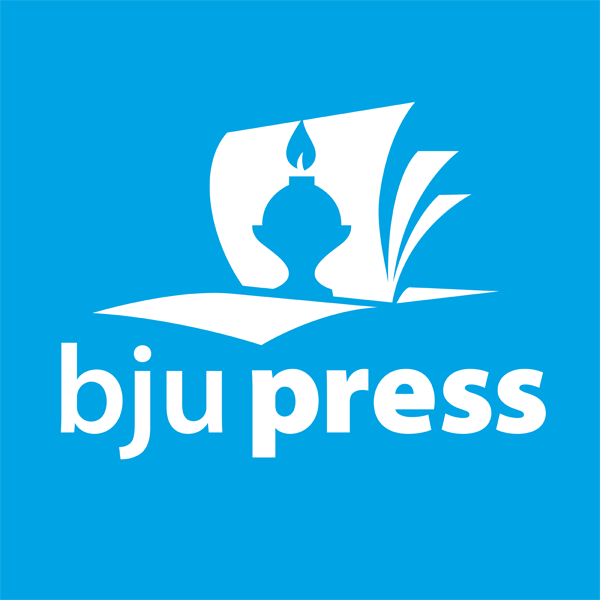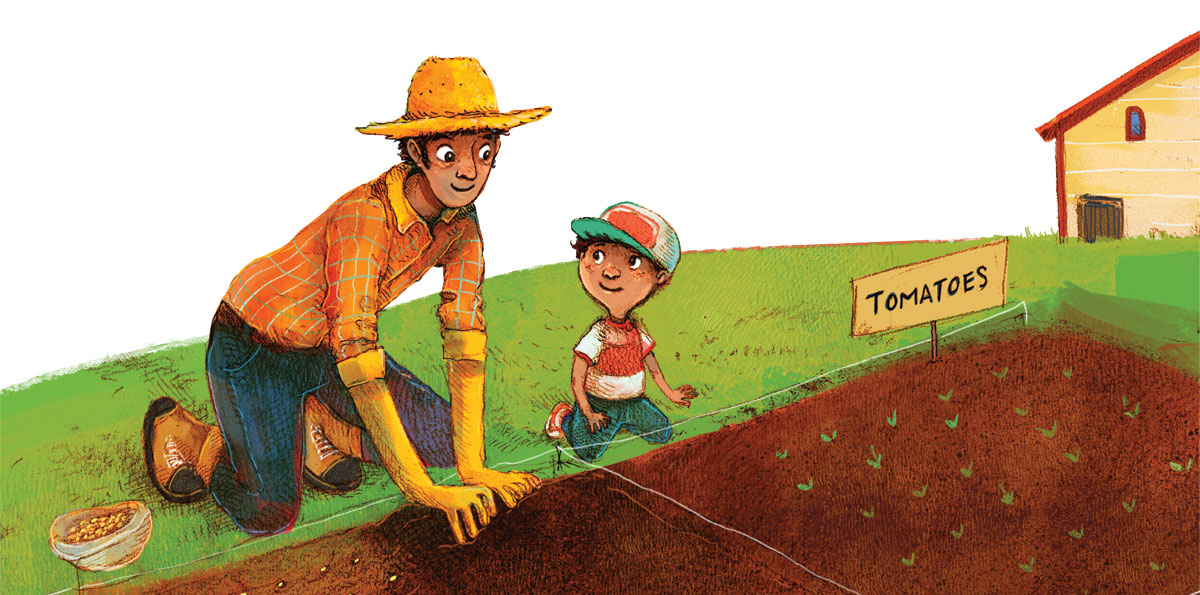The BJU Press elementary reading program challenges students to engage with what they read. Literature—whether it is fiction, nonfiction, drama, or poetry—enables people to consider, make sense of, celebrate, lament, and even change the world. We want students to enjoy reading all types of literature so that they will become lifelong readers. We also want them to analyze, interpret, and evaluate everything they read from a biblical worldview. More than any other people, Christians should value reading because God reveals Himself to His people through a book. In addition to helping us know God, reading skills also prepare us to be better servants of Christ. The apostle Paul lays out for us the standard by which Christians should measure what they read: things that are true, honorable, right, pure, lovely, and commendable (Phil. 4:8). In other words, we should read that which conveys truth, goodness, and beauty.
Vision
To equip students to enjoy lifelong reading, to analyze and interpret texts in a variety of genres, to evaluate all that they read from a biblical worldview, and to become effective communicators.
Goals
- To foster the joy of reading
- To differentiate instruction with reading groups to meet the instructional needs of individual students
- To integrate a systematic phonics approach to decoding and word-work instruction
- To teach vocabulary in context
- To promote fluency through silent and oral practice to ensure accuracy and automaticity
- To enhance comprehension through knowledge-building selections
- To develop discernment by evaluating literature from a biblical worldview
Program Approach for Reading
The BJU Press elementary reading program challenges students to engage with what they read. Literature—whether it is fiction, nonfiction, drama, or poetry—enables people to consider, make sense of, celebrate, lament, and even change the world. We want students to enjoy reading all types of literature so that they will become lifelong readers. We also want them to analyze, interpret, and evaluate everything they read from a biblical worldview. More than any other people, Christians should value reading because God reveals Himself to His people through a book. In addition to helping us know God, reading skills also prepare us to be better servants of Christ. The apostle Paul lays out for us the standard by which Christians should measure what they read: things that are true, honorable, right, pure, lovely, and commendable (Phil. 4:8). In other words, we should read that which conveys truth, goodness, and beauty.
Fostering the Joy of Reading
Students who are properly equipped to read are more likely to enjoy reading so much that they will pursue it on their own. However, in order to get there, students must have a reason to start reading. Our hope is that a lifelong love for reading begins in each student using our elementary reading materials. The teacher materials, basal readers, and novel studies have been designed to motivate and engage the students with a wide variety of literature. Teacher editions provide suggestions for exciting introductions and interactive lessons that help capture students’ attention before they start reading. The basal readers use a colorful design with a balance between open space and text. Each selection is age-appropriate and leveled according to student ability, and the selections offer variety between author styles and genres. Students should have every opportunity to actively participate in each lesson.
Differentiating Instruction
The BJU Press reading teacher editions encourage using reading groups so that teachers can tailor instruction to student needs. Teachers can move at a slower or faster pace according to the needs of each group. The teacher editions offer additional opportunities for scaffolded learning, as well as questions that can be selected or adapted to meet the abilities of the group.
Integrating a Systematic Phonics Approach to Decoding
Because the study of phonics is an important tool for teaching reading, the BJU Press elementary reading program begins phonemic awareness and instruction in K3–K5 and progresses to systematic phonics instruction starting in grade 1. Students are introduced to the forty-four sounds of the English language by using phonemic awareness activities that emphasize identifying the beginning, middle, and ending sounds of words. The program also highlights reliable syllable patterns in one-syllable words that students can later apply to more complex words. Students will be able to practice and learn letter-sound association and syllable patterns by using phonograms, or word families—a set of words that share the same vowel pattern as well as the same consonant pattern after the vowel pattern.
Teaching Vocabulary in Context
The elementary reading program provides strategies for learning new vocabulary words from the surrounding contexts. Students will learn to determine the meaning of unfamiliar words so that they can become more proficient readers. As they find new words and learn their meanings, students will be able to use them in discussion and apply comprehension in worktext activities.
Promoting Fluency
To develop reading fluency, students need regular opportunities to apply the strategies they have learned during silent and oral reading. The basal readers and additional novel studies included in the reading program offer abundant opportunities for silent reading practice, while the teacher edition offers suggestions for oral reading practice. Silent reading is a vital life skill that is strongly emphasized throughout the BJU Press reading program. However, it’s a difficult skill to assess. The teacher edition will include direction on measuring a student’s silent reading skills, including observing the student’s ability to use context clues to determine unknown words, to apply metacognitive skills to the reading, and to demonstrate comprehension. Oral reading, on the other hand, is a demonstrative skill that gives students an opportunity to communicate what they have learned. Again, the teacher edition will include guidelines for assessing oral reading. Students excel at oral reading when their reading sounds like normal speech and when it demonstrates phrasing, pacing, and rhythm that match the meaning of the text. While both oral and silent reading have their functions in a reading lesson, the teacher editions emphasize having each student read silently at his or her own pace before reading it aloud or discussing it.
Enhancing Comprehension
The BJU Press elementary reading program teaches students key strategies for developing reading comprehension. Along with continued phonics instruction to reinforce early reading skills, students will learn reading strategies for comprehension. The teacher and student editions give suggestions for a reading-process approach (before reading, during reading, and after reading) for introducing a text and maintaining focus for comprehension. Close reading strategies will help students get more from a story in a single reading. Questions in the student text will encourage students to find cause-and-effect relationships within the text, while self-monitoring questions will help them stay focused on key details during reading. Students will also be able to study literary terms that help them to understand not only what is happening in a story, but also why it’s happening. The teacher edition offers suggestions for using graphic organizers for understanding the text and organizing information, including Venn diagrams and KWL charts. These items can also be found on Teacher Tools Online. Discussion questions in the teacher edition develop higher-order thinking skills. Additionally, the reading skills and strategies developed throughout the program naturally translate to Bible study.
Developing Discernment by Evaluation from a Biblical Worldview
Ultimately, students must learn discernment as they decide the value of the literature they read and what literature they will read on their own. Lessons integrate biblical principles that help students evaluate what they read through the lens of the Bible. Selections in the student edition will point students to specific statements in Scripture that help them respond to the texts they read. Retellings of Bible accounts and selections taken directly from the Bible teach students to read Scripture using the reading strategies they have developed throughout the course.
Reading: The Key to Language Arts
At BJU Press, we want to challenge students both spiritually and academically. We want them to grow as they are learning to think biblically, applying critical-thinking skills, and enjoying what they learn. The key to success across all the subject areas and even throughout life is reading ability. An integrated, well-balanced language arts program is crucial to helping students achieve this success. It provides practice with skills necessary for all other content areas. BJU Press phonics, reading, spelling, handwriting, and English materials offer a consistent and progressive approach to all components of language arts—including writing. A reading program that does not incorporate writing skills is not reaching its full potential. The BJU Press reading program includes a heavy emphasis on developing writing skills for communicating effectively in a God-honoring way. Students will have opportunities to apply grammar, spelling, and handwriting skills as well as practice responding to literature through writing.
Materials
Student Edition
The student edition readers provide interesting, developmentally appropriate selections from a variety of genres. The level of difficulty progresses in readability and skills to give students every opportunity for success. Bible retellings closely follow the text in Scripture to translate reading skills into Bible study skills.
Student Activities
Student activities include independent practice materials that reinforce skills covered in the lessons, including application of phonics, vocabulary, comprehension, and composition.
Teacher Edition
Each grade’s teacher edition includes detailed lesson guides with vocabulary sentences and literary instruction, literal and higher-order discussion questions, and pre-reading and post-reading activities to meet multiple learning styles. Grades 1–3 also include phonics instruction or review as a component of the reading lesson.
Additional Resources
Numerous resources are available on Teacher Tools Online to supplement and enhance classroom teaching. These features include instructional aids, assessment rubrics and explanations, biquarterly assessments, book report ideas, and digital copies of activities answer keys.
Assessments
Assessments packets provide tools to determine whether students can demonstrate proficiency in three components in the reading process: comprehension from silent reading, oral fluency from read-alouds, and written comprehension. The packet includes rubrics for determining a grade for these components as well as reading comprehension tests for grades 2–5 (grade 1 comprehension assessments are located in the back of the teacher edition). Each packet includes teacher instructions, answer keys, rubrics, and reproducible tests.
Novel Studies
If using novel studies, purchase individual copies for each student in the group or class. Teaching guides for integrated novel studies are included either as BJ Booklink guides in grades 2–3 or in a volume of the teacher edition in grades 1, 4–5.
Scope & Sequence
Auditory Discrimination
Distinguish long from short vowel sounds in spoken words; segment and blend sounds to form words; isolate and pronounce initial, medial, and final sounds; syllabication using vowel sounds; identify rhyming words
Letter-Sound Association
Spelling-sound correspondence of common consonant digraphs; decode one- and two-syllable words (syllabication); decode words with inflectional endings; recognize and read first-grade irregularly spelled words (high-frequency words)
Fluency
Read grade-level text aloud with accuracy and appropriate expression; use context to self-correct, rereading as necessary
Main Ideas and Details
Ask and answer questions; retell stories, including key details; identify main topic and important details; describe characters; describe connections between characters, events, or ideas in text; identify setting; sequence events
Author’s Craft / Text Structure
Identify figurative language and onomatopoeia; identify sensory details; identify fiction vs. nonfiction; identify different genres of text; identify speaker / point of view; ask and answer clarifying questions; identify and interpret text features and graphic features; identify problem and solution
Integration of Knowledge and Ideas
Use illustrations to describe characters, setting, events (fiction), or key ideas (nonfiction); make inferences from illustrations; draw conclusions using background knowledge or textual information; identify basic similarities and differences between two texts on the same subject; compare and contrast characters’ experiences in stories; make and verify predictions; make text-to-self connections, text-to-text connections, and text-to-world connections
Character Analysis
Identify character traits; infer character motives; identify character emotions; evaluate characters’ traits and actions
Composition
Formulate a different ending to a story; compose poems featuring onomatopoeia and elements of shape
Phonics and Word Recognition
Re-teaching of phonics: a review of the forty—four sounds of English with many of the variant spellings; Open/closed syllables, counting syllables, syllable division, base words/prefixes/suffixes, VC/CV pattern, compound words, consonant + -le; Service words
Vocabulary
Meaning from context; Synonyms; Antonyms; Prefixes; Suffixes; Analogies; Compound words; Contractions
Comprehension
Literal, interpretative, critical, appreciative levels; Biblical truth; Interpret pictures, follow directions, sequence, classify, compare and contrast, cause and effect, problem and solution; Make inferences, draw conclusions, predict outcomes; True/false statements, time/place relationships, relevant information, facts/opinions, main idea; Punctuation, capitalization, abbreviations, comparatives/superlatives, possessives, pronouns, action words, describing words
Literature
Reading a variety of genres: realistic fiction, historical fiction, fantasy, fable, folktale, tall tale, article, Bible account, biography, drama, mystery; Main character, character development, motives, traits; Setting, plot, point of view, fanciful elements, idioms, imagery, similes, figurative language; Poetry: rhyme, rhythm, repetition, onomatopoeia, alliteration
Study Skills
Book parts: title, author, illustrator, contents, glossary; Alphabetizing, books of the Bible, calendar, recipe, poem stanzas, hymn stanzas, captions, headings, maps, diagrams, graphs, graphic organizers
Fluency
Silent Reading: read for understanding, specific information, biblical truth, author's message; Oral Reading: communicate message of the author, language-like flow, communicate meaning, mood, portray characters, emotion, respond to punctuation, convey dialogue
Composition
Writing in response to reading; Descriptions, personal experiences, poems; Alternate story ending
Phonics and Word Recognition
Phonics review, introduction of additional variant spellings; Syllable division: base words/prefixes/suffixes, VC/CV pattern, compound words, prefixes/suffixes, two-syllable words, words ending with -tion, consonants + le, schwa syllables; Service words review
Vocabulary
Meaning from context; Synonyms; Antonyms; Analogies; Compound words; Contractions
Comprehension
Literal, interpretative, critical, appreciative levels; Biblical truth; Sequence, classify, compare and contrast, cause and effect, problem and solution; Make inferences, draw conclusions, predict outcomes; Time/place relationships, relevant information, facts/opinions, main idea; Punctuation, capitalization, abbreviations, comparatives/superlatives, possessives, pronouns, verbs, adverbs, adjectives
Literature
Reading a variety of genres: realistic fiction, historical fiction, fantasy, fable, folktale, tall tale, article, Bible account, biography, poetry, play, nonfiction, legend; Main character, character development, motives, traits; Setting, plot, point of view, fanciful elements, conflict, foreshadowing, fanciful elements; Poetry: rhyme, rhythm, onomatopoeia, alliteration, quatrains; Idioms: imagery, personification, metaphor, simile, humor, sarcasm, suspense
Study Skills
Book parts: contents, glossary; Encyclopedia, Bible concordance, cross-references, biographical dictionary, newspaper, classified ad; Skimming, scanning, PQ3R study method; Calendar, maps, diagrams, graphs, timeline, schedule
Fluency
Silent Reading: read for understanding, specific information, biblical truth, author's message; Oral Reading: communicate message of the author, language-like flow, communicate meaning, mood, portray characters, emotion, respond to punctuation, choral reading
Composition
Poetry, simile, rhyming riddles, alliterative phrases; News article, classified ad, personal experience, journal entry, friendly letter, persuasive essay, descriptive paragraph; Story mapping, play writing, tall tale, research writing, decree/law, financial report
Word Recognition
Optional remedial phonics
Vocabulary
Meaning from context; Synonyms; Antonyms; Analogies; Greek and Latin roots; Multiple Meanings
Comprehension
Literal and higher-order levels; Sequence, classify, compare and contrastm cause and effect, problem and solution; Make inferences, draw conclusions, predict outcomes; Place/size/time relationships, relevant/irrelevant information, facts/opinion, main idea, dialect, discernment, sense of history; Biblical discernment and cultural awareness
Literature
Reading a variety of genres: realistic fiction, historical fiction, Christian fiction, mystery, biography, autobiography, narrative nonfiction, informational text, procedural text, proverbs, parables, psalm, Bible account, fantasy, folktale, fable, tall tale, myth, poetry, reader’s theater, play; Main character, character motives, traits, background, and development; Setting, plot, theme, cause and effect, climax, point of view, conflict, foreshadowing, irony, moral, mood, suspense, good/evil elements, humor, symbol, word play, main idea and supporting details, worldview; Imagery, personification, onomatopoeia, metaphor, simile, exaggeration, dialect, palindrome; Poetry: free verse, haiku, limerick, acrostic, shape poems; rhyme, rhythm
Study Skills
Glossary, dictionary, Bible concordance, Bible study, internet research; Maps, timelines, diagrams, graphs, charts, sidebars, captions, titles, subtitles/section titles
Fluency
Silent Reading: for information, entertainment, understanding, spiritual growth, author's message, biblical truth; Oral Reading: communicate message of the author, communicate mood and motive, portray characters, convey emotion, convey meaning of Scripture, voice inflection, volume and pacing
Composition
Metaphor, simile, haiku, limerick, acrostic, folktale ending, letter, journal entry, research writing, interview
Vocabulary
Meaning from context; synonyms; antonyms; analogies; Greek and Latin roots; multiple meanings
Comprehension
Literal and higher-order levels; Sequence; classify; compare and contrast; cause and effect; problem and solution; Make inferences; draw conclusions; predict outcomes; summarize; Self-monitoring; facts/opinion; main idea and supporting details; sense of history; Biblical discernment and cultural awareness
Literature
Various genres: realistic fiction, historical fiction, Christian fiction, science fiction, mystery, biography, autobiography, narrative nonfiction, informational text, procedural text, proverbs, Bible prophecy, Bible account, fantasy, folktale, fable, tall tale, myth, poetry, reader’s theater; Main character; character motives, traits, background, dialect, development; Setting; plot; theme; cause and effect; climax; rising and falling action; point of view; conflict; foreshadowing; humor; invented words; irony; moral; mood; suspense; symbol; rhetorical questions; tone; wordplay; worldview; Imagery; personification; onomatopoeia; metaphor; simile; exaggeration; dialect; Poetry: free verse, limerick, hymn, sonnet, tanka, riddles, rhyme, rhythm
Study Skills
Glossary; dictionary; Bible concordance; Bible study; Summarizing; skimming; internet research; digital literacy; Maps; timelines; diagrams; graphs; charts; sidebars; captions; titles; subtitles/section titles
Book Reports
Writing process used to prepare and present written and oral book reports
Fluency
Silent reading: for information, entertainment, understanding, spiritual growth, author’s message, and biblical truth; Oral reading: communicate author’s message; communicate mood and motive; convey emotion; portray character; convey meaning of Scripture; voice inflection; volume and pacing
Composition
Metaphor; simile; haiku; tanka; limerick; letter; journal entry; research writing; interview








